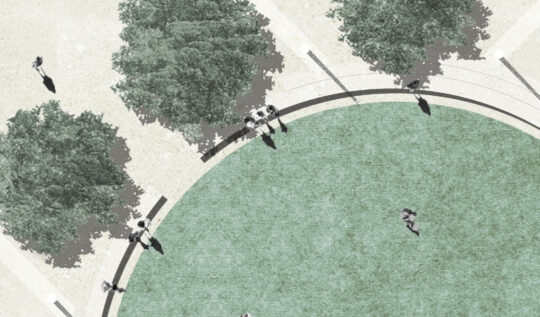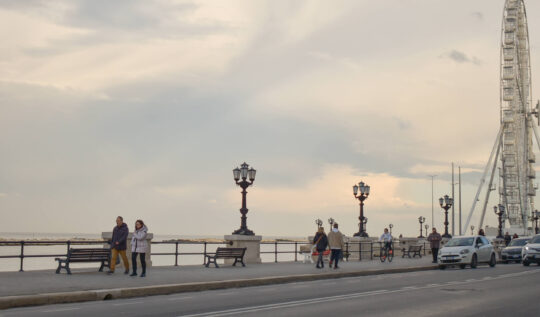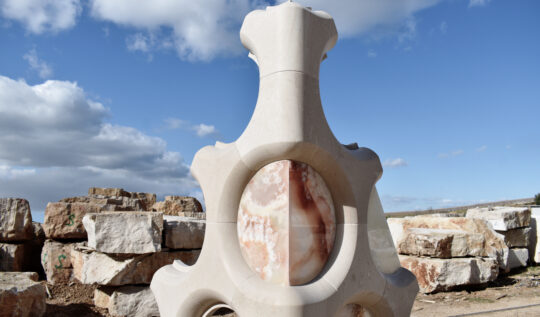
Bari si fa bella!
It is known: “Bari is Bari,” and with time it becomes more and more magical. In fact, in the past decade, we have witnessed exponential growth of the Apulian capital, which has been the setting for several successful movies and TV series and in 2022 hosted more than 435,000 tourists. The municipality is still developing today; it is witnessing a process of urban renewal that has led to major changes in the architectural and aesthetic landscape. The urban reform project includes expanding pedestrian areas, creating and widening the road network in order to improve connections between various neighborhoods and reduce traffic. There are numerous interventions for the redevelopment of public green areas. In short, Bari is working hard to improve its face day by day but, let’s start from the beginning: what are the architectures and places that characterize it and have always characterized it? Who are the key players in this continued growth of the city?
“Bari Vecchia” – Historical centre of town
Non potevamo che non iniziare con il parlare della città vecchia di Bari: uno spettacolo straordinario da ammirare. È un concentrato di storia, cultura, architettura e tradizioni che si riflette in ogni sua parte. Bari vecchia è un mix di antiche strade e vicoli, chiese, palazzi nobiliari e piccoli negozi. Alcune vie sono pavimentate con ciottoli di basalto, mentre altre sono costituite da antiche basole di pietra. La maggior parte delle strade è delimitata da muri di mattoni con piccole finestre che permettono ai passanti di ammirare l’interno dei palazzi. I vicoli stretti sono collegati ai palazzi con archi e architravi. Tra queste vie, la più conosciuta è via Arco Basso: “la strada delle orecchiette” dove le massaie allestiscono tavolo e tavoliere e preparano le tipiche orecchiette. Un altro elemento di Bari vecchia sono le piccole botteghe che si trovano in ogni angolo della città. Si tratta di negozi di antiquariato, negozi di alimentari, gioiellerie e negozi di artigianato. Sono caratterizzati da un design tradizionale e sono ricchi di dettagli architettonici che riflettono i secoli di storia della città. Una costante nell’architettura di Bari vecchia sono le chiese. La città è infatti ricca di piccole e grandi chiese e cattedrali che spiccano per le loro facciate in stile gotico, barocco e romanico. The bell towers are often decorated with statues and ornamental motifs, while the facades are embellished with sculptures and architecture that testify to the city’s cultural richness. The aristocratic palaces found in the old city, in the Murattiano suburb, are an authentic architectural jewel. They are buildings of great grandeur, with richly decorated facades and wrought-iron balconies. The windows are usually framed with numerous floral motifs; many of these buildings are richly frescoed. All this makes old Bari a magical place. A journey between history and tradition, between architecture and culture. A place where time seems to stand still and where it is possible to breathe in the atmosphere of yesteryear.
Mercantile Square
Piazza Mercantile is a historic square located in the historic center of Bari. It is located at the foot of an ancient Renaissance fortress overlooking the sea. The square is one of the largest and oldest squares in the city and has also been the epicenter of commercial life for centuries. The square was built in the 16th century and was used as a trading area for ships arriving in Bari from the Mediterranean. It saw the passage of several emperors, generals and merchants, such asEmperor Charles V in 1535, who signed a treaty with the city. During the 18th century, Piazza Mercantile was one of the largest and busiest squares in Bari. The square was the center of lively commercial activity and cultural exchange. Local merchants and those from other parts of the region came here to trade. An open-air market was held here, where food, handicrafts, textiles, furniture and other goods were sold. In recent decades, Mercantile Square has seen some major changes: it has been restored, renewing the pavement with Minervino stone basalt tiles provided by us (along with a number of accessories such as traffic bollards); it has been equipped with a fountain from the Roman era and a statue of a woman representing the city. È stata dotata inoltre, di una rete di strade pedonali, che hanno collegato la piazza con il porto, rendendo la piazza più accessibile. Today, Piazza Mercantile is one of the most visited places in Bari. It is one of the city’s main tourist attractions and is a great place to walk around, relax and enjoy local cuisine or have coffee with friends. Various festivals, concerts, shows and other cultural events take place here.
Nazario Sauro Promenade
It is one of the largest and most scenic coastlines in Apulia. It starts at Punta Perotti, south of the city, and extends six kilometers to Punta Prosciutto, to the north. Along its route, it has witnessed numerous historical events and offers breathtaking views of the Adriatic coast. Initially, the waterfront was an expanse of white sand and blue sea overlooked by the city of Bari. In 1923, the Italian government decided to build a waterfront road connecting Bari to neighboring towns. Thus it was that Nazario Sauro Road, in honor of the Italian admiral who led the fleet during World War I, began to be built. Along the way, numerous buildings were constructed, including the Church of St. Nicholas, the Tower of St. Christopher, the Bari Aquarium, the Petruzzelli Theater, the Government Palace, the Basilica of St. Nicholas, and the Swabian Castle. Several benches, fountains, sculptures and other decorative elements have made the waterfront a pleasant place to visit. Today, the Nazario Sauro waterfront is the symbol of the city overlooking the Adriatic Sea for which we provided the basis for the lampposts that are the protagonists, along with the landscape, of Bari’s most emblematic postcards.
Petruzzelli Theater
Bari’s Petruzzelli Theater is one of Italy’s most important theaters and is considered one of southern Italy’s most valuable cultural heritages. Its history dates back to 1889 when it was built by the Petruzzelli brothers, Giuseppe and Domenico, who had planned it as a drama theater. Over the years, the Theater has seen both classical and contemporary performances by internationally recognized artists and companies. In 1927 the building was enlarged with the construction of new boxes and galleries designed by architect Umberto Brunelleschi. Then in 1948 the Petruzzelli Theater was purchased by the City of Barletta to become a public cultural center and to be enjoyed by all Barletta citizens. Public interventionism was not only limited to expansion but also to financing the theater companies presented on the stage. After World War II, the facility’s cultural activities expanded greatly with the aim of promoting the local area. On Oct. 14, 1993, the theater suffered a tragic fire; the reconstruction of the theater took shape in the intentions of the city’s municipal administration to promote an accurate reconstruction that would reflect the original grandeur of this historic structure. In fact, in February 1996, reconstruction work and the construction of new multipurpose rooms began. As part of the theater’s redevelopment, there is room for paving the area outside the building with traffic bollards that conceal the LED lighting system. Finally, in 2009 it was inaugurated in the presence of distinguished artistic directors and other prominent figures. Today, the cultural mission of this place is to continue to promote the arts and offer diverse reading opportunities to the population of the region’s cultural policies.
Parks and green areas
The municipality held competitions to restore some abandoned areas and buildings. Prominent among them is the Rossani Barracks, a historic military structure in the city, built in 1859 and named after General Carlo Rossani, who served in the Italian army during the Second War of Independence. The barracks, closed in 1991, was also home to the Italian Army’s Officer Cadet School. Il progetto del ripristino dello spazio esterno, al fine di ampliare l’offerta di spazi pubblici destinati alla socializzazione e alla pratica sportiva, ha la firma dell’architetto Massimiliano Fuksas, autore del restyling della stazione Centrale di Bari. È il più grande parco urbano della città. L’area verde si sviluppa su una superficie di circa 30.000 mq ed è situata a sud di piazza Aldo Moro, al di là dei binari, in corrispondenza del nuovo volto della stazione. All’interno del parco sono previste aree destinate alla pratica sportiva, come il campo da basket e l’area per lo skate, e spazi giochi per bambini. Viene recuperata così un’area che per anni è stata sotto utilizzata dai cittadini.
New residential complexes
A big player in the 2023 news in this area of Bari’s city renewal is the project of architect Stefano Boeri, who envisions a reinterpretation of his green skyscraper project in Milan in a reduced key adapted to the Bari context. Boeri’s green forest project has become world famous as an innovative form of architecture that combines a positive environmental impact with an urban lifestyle. This has been repurposed in Bari as a complex of 130 apartments in 8 floors overlooking the waterfront that, similar to the Milan complex, will house over trees, shrubs and plants of various kinds. Used not only to decorate the building but also to reduce air pollution, greenhouse effect and noise pollution. In addition, the trees and plants provide a resting area for birds and insects, thus improving the biodiversity of the area. Boeri’s Bosco Verticale is an example of how architecture can contribute positively to the environment, and now, the city of Bari, too, will welcome “a tree house that also houses humans and birds.”
Suburban areas
These redevelopments are concentrated not only in the metropolitan city of Bari but also in the districts and neighborhoods on the fringes. San Girolamo, located on the northwestern outskirts of the Apulian capital and enclosed between two blades, is Bari’s only neighborhood in close contact with the Adriatic Sea. In 2019, the ward saw the creation of a new kilometer-long “waterfront” for which we were asked to create furniture elements such as bollards and seating, as well as the stairs leading from the pedestrian area of the IX Maggio waterfront to the beach. Another ward undergoing restyling is Torre a Mare, a neighborhood located in the northern part of the city. It is one of the oldest neighborhoods in the city, and has a history dating back to the 16th century, consisting of a series of historic buildings and streets, stretching out to the sea. Again, the protagonist of the intervention is the relationship between the sea and the village promoted by the pedestrianization of the coastal road, for which we made the overlay maps positioned around the entire perimeter of the redeveloped stretch of waterfront, and those that enclose the decorative shrubs; these have the function of large linear seats. However, the sea is not the only protagonist. The G124 project, coordinated by architect Renzo Piano studies the settlement unity of the St. Paul neighborhood and promotes an intervention of “urban mending” between the new building and the old. In summary, Bari is increasingly becoming a modern, welcoming and vibrant city that is trying to enhance its historical and cultural heritage and become a major tourist destination in southern Italy. This is thanks to the help of international professionals and a thoughtful, forward-looking administration. By now it is established: “Bari is Bari” and it is beautiful. We are proud to have collaborated, at least in part, to make it so and hope to continue to do so.



